Animals
Do You Know The ABC’s Of Pet Behavior?
NOTE: I have a new pet behavior blog located at http://www.SoMuchPETential.com/blog. Thanks!
(past Hyde Park Living column)
Do you know your ABC’s?
Well that’s a strange question you may be saying to yourself. Isn’t this a pet behavior column?
Yep, it sure is. And the ABC’s I’m talking about are not related to spelling words. They are instead what I have been taught to help me understand why a behavior occurs so that as a pet owner and teacher, I can effectively set my animals up for success by influencing their behavior in the most positive/least intrusive way.
Let me back up. What I really would like for you to get from this column is a basic understanding that blaming an animal for doing anything you don’t want him to do is simply counterproductive. All behavior happens because it is serving a purpose for that animal. We may never know at any given time what our animal is feeling or thinking when he jumps on us or chews up a garden hose but we don’t need to know to still set our animal up to succeed. Using the ABC assessment, we can modify the animal’s environment and modify his behavior without any use of force or punishment.
The science of behavior
Applied behavior analysis is a systematic approach to solving behavior problems by changing the environment in which the behavior occurs. It involves looking at the very specific behavior (such as a bird biting or screaming) and the related environmental context that signals and reinforces it. We ask, “What happened *immediately* prior to the behavior (antecedent) to set the whole ball rolling?“ And, “What happened *immediately* after the behavior to reinforce it (consequence)?“
 There you have it…the A (antecedent), B (behavior), and C (consequence)’s.
There you have it…the A (antecedent), B (behavior), and C (consequence)’s.
All too often when our pet is doing something we disapprove of we don’t even realize that we are responsible for reinforcing the very action we don’t want to see. Or in the heat of the moment, we end up punishing our pet – which can have detrimental side effects (the subject for a future column) and serves no teaching function.
Using the ABC assessment tool allows us to consider how we can rearrange the antecedents so that the problem behavior is never set into motion to begin with – and we can set into motion an acceptable behavior instead. Then we can reinforce the heck out of the acceptable behavior. Guess which behavior you’ll see more of?
In my next column I’ll work through a specific example of using the ABC analysis in solving a pet behavior issue.
Note To Barnaby About Training With Positive Reinforcement
NOTE: I have a new pet behavior blog located at http://www.SoMuchPETential.com/blog. Thanks!
Dear Barnaby, I appreciate that you want to be my helper in training Chester to wave. But please remember, training with positive reinforcement means only rewarding the CORRECT behavior.
(by the way, Barnaby is my Timneh African Grey)
Emilie Buchwald Is The Voice For Those Without One
NOTE: I have a new pet behavior blog located at http://www.SoMuchPETential.com/blog. Thanks!
It is a beautiful heart that can see into the eyes of children their potential for caring and love, and into the souls of animals who have no voice to speak of their needs. Love, safety, nourishment, and play ~ life’s precious gifts that can so often be taken for granted are not always available to everyone. And especially not to some, whose only wrongdoing was being born.
But, what if young, impressionable minds were taught responsibility for those without human language? What if those who are less fortunate are given opportunities? They are given a voice.
Emilie Buchwald is that voice.
And I love her language.
 A friend introduced me to his mother-in-law a few weeks back. He had a hunch she and I would have something in common. He was right.
A friend introduced me to his mother-in-law a few weeks back. He had a hunch she and I would have something in common. He was right.
Emilie is the author of two award-winning children’s novels. A poet and a fiction writer, she has taught literature, poetry, and writing for children. She has a Master of Arts in English and a Ph.D. in English Literature, and an honorary Doctor of Humane Letters from the University of Minnesota. Emilie is the publisher emeritus and co-founder of Milkweed Editions, the editor or co-editor of 200 books that have won more than 200 awards and distinctions, with a million books in print when she retired in 2003. She has received the McKnight Artist of the Year Award, the Kay Sexton Award for service to Minnesota’s literary community, and, in 2008, the National Book Critic’s Circle Lifetime Achievement Award.
(No, her credentials are not what we have in common although I find writing very fulfilling and have always thought it would be fun to write children’s books ~ but the credentials do make it a little intimidating to be writing about her. )
Actually, it is what Emilie has chosen to pursue with her ‘free time’ now that she is officially ‘retired’ that connects us. In 2006, after a long and accomplished career, she began a new journey. She founded The Gryphon Press to create high-quality children’s picture books whose ultimate purpose is to educate kids about important animal issues and the human-animal connection. (It wasn’t mentioned in her bio but Emilie also happens to be a passionate advocate for those who don’t speak human.)
Her publishing company, The Gryphon Press, is named for the mythical bird that represents fair play and justice. It has sold over 400,000 books to date ~ each one compellingly written and movingly illustrated to engage kids in learning about the responsibilities of dog ownership, pet adoption and overpopulation, getting rid of puppy mills, therapy and service dogs, the intelligence of dogs, dog parks, issues of abuse, and more. Most books have won national awards.
“I love the process of putting an artist and an author together, seeing a book take shape and putting it through production but I wouldn’t have gotten back into this if it wasn’t for an important reason,” she told me. “I was reading blogs and stories about how difficult it is to educate about animals and I just thought, ‘I know how to publish books. I can publish books for kids about this and talk in terms they can understand.’ This is a wonderful way to change things.”
Yes, Emilie, it is!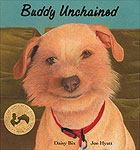
Take for example, Buddy Unchained, the story of a happily rehomed mixed-breed dog who shares his sad memories of life before being rescued. The book sends a powerful message that caring humans can and do help, and includes resource information for adult readers.
Or Always Blue for Chicu, the daunting story of a smuggled parrot’s neglect and suffering who is ultimately rescued and reunited with his soul mate. The book makes the clear point that a bird 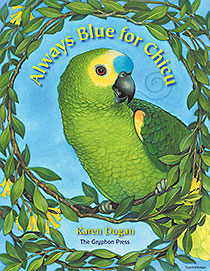 is a wild animal and formidable pet that can live a very long life and will require significant attention.
is a wild animal and formidable pet that can live a very long life and will require significant attention.
Or Are You Ready For Me?, a book (written by Emilie’s daughter, Claire) that helps parents answer the common question ~ “Please, can we get a dog?”. In this story, a dog and puppy at and adoption center ask two children how they will be treated.
Schools and other educational institutions are using The Gryphon Press books and creating lesson plans around them.
“It’s very satisfying to me,” said Emilie. “I’ve had instances where teachers have cried because they haven’t had a way of teaching these kinds of lessons before. I get letters all the time and see kids using our books.”
The only frustration? “Not being able to do more,” Emilie told me.
To that, I’ve got to say…Emilie, you have done A LOT.
And “THANK YOU!”
Solving Problem Parrot Chewing With Enrichment
NOTE: I have a new pet behavior blog located at http://www.SoMuchPETential.com/blog. Thanks!
(a Hyde Park Living column written a number of years ago when my dear Chester was still with us)
In the days before Barnaby joined our flock, there was just Chester, Dreyfuss and me living together in a large two bedroom apartment. It actually was a wonderful place with many of the rooms being larger than those in my house and the large sliding glass window in the dining room made for a scenic view of the woods in the back. Pink floor length curtains hung from its side with a hand made valence (made by me) stretching across the top.
Chester and Dreyfuss stayed in the dining room, their cages arranged on a wall at either end of the table.
It made for some interesting meetings (I work from my home) and dinners with the family. Whoever thought only dogs begged for food has certainly never met my guys!
That was long before I had ever heard of behavioral analysis, and creating an enriching environment, well, that meant putting some acrylic toys in their cages, right??? I got them at the pet store, and they were labeled ‘bird toys’ after all.
I did a lot of things differently back then, and, as a result, so did the guys. Take for example those flowing, opaque pink curtains that were no longer transparent to the sun’s afternoon rays by the time I bought a house. If you’re ever looking for an awesome playgym for your parrot, I’ve got a suggestion. To Chester, they were the greatest thing next to safflower seeds. He’d slide down his cage stand, waddle across the floor and climb to his heart’s content. Up, down, right, left. If he was on the outer edge, he could swing it around so that only his head would stick out. And, if I didn’t find him while he was playing monkey on the curtains, he’d make it all the way up to the valence. I can’t tell you how many times I’d walk out to find him hanging upside down. When he’d see me, he’d tilt his head up as if to say ‘look mom, look at me!’
I was so frustrated because I couldn’t stop him, but at the same time, if you’ve ever seen an Alexandrine hanging upside down with such a comical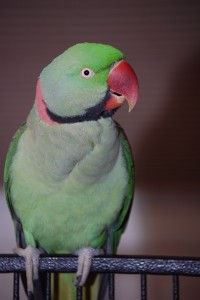 look about him, you can’t help but laugh. It’s just so funny.
look about him, you can’t help but laugh. It’s just so funny.
Then there was the time when I was on the telephone in a back bedroom and suddenly I heard C*R*U*N*C*H. That was the sound of a dining room chair being disassembled by a beak that didn’t have anything better to chew on. <sigh>
Needless to say, I was determined when we moved, that history was NOT going to repeat itself. And thankfully now, I have the knowledge to prevent it. (at least so far – and it’s been nine years)
It’s easy to look back on the situation now and see how Chester’s environment wasn’t setting him up for success, at least success through my eyes.
With a behavioral analysis hat on, let’s look at his curtain climbing antics.
Background: Chester is activity and Lisa deprived.
Antecedent: curtains were in view
Behavior: Chester waddled over and climbed the curtains
Consequence: sensory feedback – stimulation from his having to use his beak and feet activity – he was busy and engage; social – if I came out, he’d get my attention
Probable Future Behavior: When Chester is activity and Lisa deprived, he’ll continue to climb the curtains
So, what have I done differently to set him up for success?
Well, honestly, I really just needed to do some antecedent changes to prevent him from destroying things here and it has solved our problem. I have created a much more enriching environment. I even keep their cage doors open while I’m working in my basement and the only reason Chester will come off his cage is if something scares him. But I’m prepared for that too.
Chester, and all of my birds, have a lot to do during the day to keep them busy. I spend hours each week making strands of knotted hemp and beads that I hang all over the inside and outside of their cages. I wrap almonds in cloth or a box or paper cup for Chester and Dreyfuss. I have portions of a phone book wrapped in string on the cage floor of Chester’s cage and hanging toys for Barnaby, my Timneh Grey, to hang from.
The list goes on but you get the picture. They are busy if they want to be, and if they want to nap, that’s fine too.
But in the instance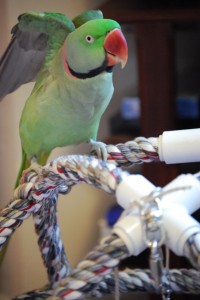 that Chester should come to the ground (and now I put him there too when I’m cleaning cages or watching tv), I’ve made some play stations for him. I got a mirrored toy from a human baby store and he can spend hours with it, so much so that I got a second one for the television room. (Scattering some beads or resting a tub of activity items next to it makes it even more reinforcing.) I bought a cheap plastic round snow sled and placed an Orbit play gym on top, tying strands of beads to it. This is also in the television room, next to the mirror toy. Chester receives such positive sensory and activity reinforcement for playing with these toys that there’s no reason for him to search out a dining room chair or curtain.
that Chester should come to the ground (and now I put him there too when I’m cleaning cages or watching tv), I’ve made some play stations for him. I got a mirrored toy from a human baby store and he can spend hours with it, so much so that I got a second one for the television room. (Scattering some beads or resting a tub of activity items next to it makes it even more reinforcing.) I bought a cheap plastic round snow sled and placed an Orbit play gym on top, tying strands of beads to it. This is also in the television room, next to the mirror toy. Chester receives such positive sensory and activity reinforcement for playing with these toys that there’s no reason for him to search out a dining room chair or curtain.
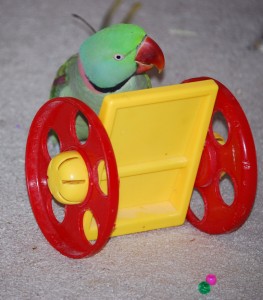 And I’d much rather laugh at him rolling his mirror toy around than hanging from my hand made valence any day!
And I’d much rather laugh at him rolling his mirror toy around than hanging from my hand made valence any day!
Spring Safety Tips For Pets
It’s hard to believe but it’s finally spring! We can all go out and work in the yard or play. I bet your pet is also enjoying the longer days and nicer weather. With the season change, I thought it’d be a good time to devote another column to reminding you of some things to consider when it comes to your furry or feathered friend.
Whether you’re in a home or an apartment, this is the time of year when we all like to keep our windows open. Please check all of your window screens to make sure there are no large holes. You don’t want to take chances on any insects, particularly mosquitoes that could have west nile virus. Birds can chew through screens so make sure their cages are kept out of reach of open windows.
In the same thought, always make sure you know where your pets are when you’re opening doors. All it takes is a split moment for a flighted bird, dog or cat to be past you on their way outside.
When it comes to spring cleaning, always be aware that household cleaners and chemicals are toxic to pets. Air fresheners can even be deadly to birds so use them with caution.
Are all of your pets’ vaccinations current? If not, now is a good time to make a visit to the vet.
Before you let your dog romp around in your back yard, if it’s fenced, make sure there is no winter damage that will allow your pet to escape. Also, this is a great time to make sure you are current with your license and identification tag, you may even want to consider microchipping as a permanent means of identification. Avoid letting your dog play in areas that have been sprayed with insecticides or other chemicals. If you suspect your dog has accidentally walked on treated lawns, call your veterinarian right away.
Additionally, it’s a good ide a to know which plants in your garden may be toxic to your pet. Here is a sample of some plants to be careful of: Azalea, Boxwood, Caladium, Chinaberry Tree, Daffodil bulbs, Elephant Ear, Foxglove, Holly berries, Hyacinth bulbs, Hydrangea, Lily of the Valley, Mushrooms, Philodendron, and Rhododendron. If you suspect your pet has eaten a poisonous plant, call your veterinarian or the Animal Poison Control Center at 888-426-4435.
a to know which plants in your garden may be toxic to your pet. Here is a sample of some plants to be careful of: Azalea, Boxwood, Caladium, Chinaberry Tree, Daffodil bulbs, Elephant Ear, Foxglove, Holly berries, Hyacinth bulbs, Hydrangea, Lily of the Valley, Mushrooms, Philodendron, and Rhododendron. If you suspect your pet has eaten a poisonous plant, call your veterinarian or the Animal Poison Control Center at 888-426-4435.
Always be mindful of conditions that could cause your pet to over heat. Heat stroke can be deadly but it’s so preventable. Never leave your pet inside an enclosed car in warm temperatures. Make sure your dog or cat has plenty of fresh, cool water and plenty of shade. Shaving your dog or cat can actually make it more susceptible to heat stroke because its fur was designed as an insulator.
If your pet is starting to overheat, one of the first warning signs is an increased and noisy panting rate. Other symptoms include thick saliva, red mucus membranes, hot skin, dazed look, vomiting and diarrhea, and an inability to move or get up. If you suspect your pet is overheating, offer small amounts of water or completely soak your pet with coot water. In extreme cases, contact your veterinarian immediately.
When it comes to traveling with your pet, make sure you call ahead. Airlines have policies on when they will and how they will allow pets to travel in cargo holds (due to safety issues with regard to the heat). If you take your dog to the beach, remember saltwater can cause vomiting or dehydration. It’s better to carry some extra water just in case. On boats, pets should always have life jackets. If you’re hiking, it’s best to avoid letting your dog drink from streams that could be contaminated with parasites and always carry a first aid kit for those unforeseen emergencies.
And, one last note. Be nice to your neighbors…clean-up after your pooch and please don’t leave a barking dog outside for hours.
Happy spring!















